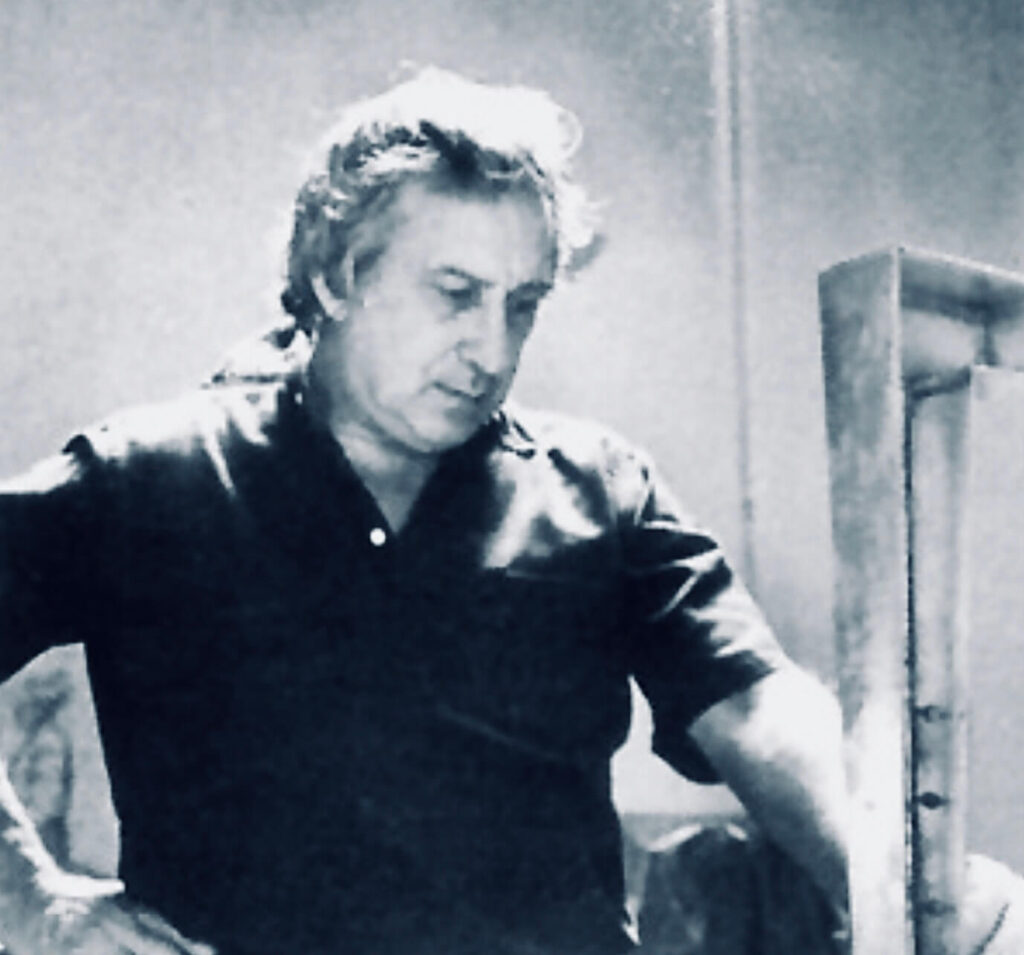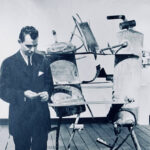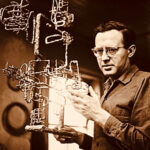James Rosati
James Rosati (1911-1988) was an American sculptor renowned for his abstract works that masterfully balanced form and space. Rosati’s sculptures, often composed of metal and stone, are celebrated for their dynamic interplay of volume, void, and light. As a significant figure in the postwar American art scene, Rosati contributed to the evolution of abstract sculpture, blending elements of cubism, constructivism, and minimalism. His innovative approach to sculpture has left a lasting impact on the art world.

Early Life and Education
James Rosati was born on March 17, 1911, in Washington, Pennsylvania. The son of Italian immigrants, Rosati grew up in a culturally rich environment that valued art and craftsmanship. His father was a stonemason, which likely influenced Rosati’s early interest in working with stone and other materials. From a young age, Rosati demonstrated a keen aptitude for art, particularly in drawing and sculpting.
In the early 1930s, Rosati moved to New York City to pursue formal art training. He studied at the Beaux-Arts Institute of Design and the Cooper Union, where he received rigorous instruction in classical sculpture techniques. During this period, Rosati was exposed to the works of modernist sculptors like Constantin Brancusi and Pablo Picasso, whose innovative approaches to form and abstraction deeply influenced his artistic development.
Transition to Abstract Sculpture
Throughout the 1940s and 1950s, Rosati’s work evolved from representational to abstract. He began experimenting with geometric forms and exploring the relationship between positive and negative space. Influenced by the burgeoning Abstract Expressionist movement, Rosati’s sculptures became increasingly dynamic, characterized by their bold, clean lines and complex spatial arrangements.
Rosati’s early abstract works were primarily composed of wood and stone, materials that allowed him to explore the interplay of mass and void. His ability to create a sense of movement and balance within his sculptures quickly garnered attention from the art community. By the late 1950s, Rosati had established himself as a prominent figure in the New York art scene.
Artistic Philosophy and Style
James Rosati’s approach to sculpture was rooted in his fascination with the fundamental principles of form and space. He believed that sculpture should engage the viewer from multiple perspectives, encouraging an active interaction with the work. Rosati’s sculptures often feature open, airy structures that invite light and shadow to play across their surfaces, enhancing their three-dimensionality.
Rosati’s style is characterized by a harmonious blend of geometric precision and organic fluidity. His works often incorporate elements of constructivism, with their emphasis on abstract, architectural forms, and minimalism, with their focus on simplicity and purity of line. Despite their abstract nature, Rosati’s sculptures convey a sense of movement and vitality, reflecting his belief that art should be a living, dynamic experience.
Important Artwork: “Ideogram” (1967)
One of James Rosati’s most significant works is “Ideogram” (1967). This large-scale steel sculpture exemplifies his mature style and his mastery of form and space.
“Ideogram” (1967)
“Ideogram” is a monumental abstract sculpture composed of welded steel. The sculpture stands approximately 40 feet tall and is characterized by its complex interplay of geometric forms and open spaces. Rosati’s use of steel, a material known for its strength and versatility, allowed him to create a structure that is both robust and airy.
The title “Ideogram” suggests a symbolic representation, and the sculpture itself can be seen as a visual language of form. The interlocking shapes and dynamic lines create a sense of rhythm and movement, guiding the viewer’s eye through the composition. The open spaces within the sculpture allow light to pass through, casting intricate shadows and enhancing the work’s dimensionality.
“Ideogram” was commissioned as part of the New York City Public Art Program and installed in the plaza of the World Trade Center in 1971. The sculpture became an iconic feature of the site, admired for its bold presence and its ability to transform the surrounding space. Tragically, “Ideogram” was destroyed in the September 11 attacks, but its legacy endures as a testament to Rosati’s vision and skill.
The significance of “Ideogram” lies in its ability to engage the viewer both visually and intellectually. The sculpture’s abstract forms invite multiple interpretations, encouraging viewers to explore their own responses to the work. Rosati’s mastery of scale and proportion, combined with his innovative use of negative space, make “Ideogram” a powerful example of his artistic achievements.
Teaching and Influence
In addition to his work as a sculptor, James Rosati was a dedicated and influential teacher. He taught at various institutions, including the Cooper Union, the Pratt Institute, and the School of Visual Arts. Rosati’s approach to teaching emphasized the importance of understanding the fundamental principles of sculpture, such as balance, proportion, and the interplay of light and shadow.
Rosati’s impact on his students was profound. He encouraged them to experiment with materials and techniques, fostering an environment of creativity and innovation. Many of his students went on to become successful artists in their own right, carrying forward Rosati’s commitment to exploring the possibilities of abstract sculpture.
Later Career and Legacy
James Rosati continued to create and exhibit his work throughout the 1970s and 1980s. His later sculptures often incorporated new materials, such as aluminum and stainless steel, reflecting his ongoing exploration of form and structure. Rosati’s work from this period is characterized by a refinement of his earlier themes, with a greater emphasis on simplicity and clarity of design.
Rosati received numerous accolades for his contributions to art, including grants from the National Endowment for the Arts and the Guggenheim Foundation. His sculptures are included in the collections of major museums and galleries, such as the Museum of Modern Art in New York and the Smithsonian American Art Museum.
Rosati’s legacy is marked by his innovative approach to sculpture and his ability to create works that engage and inspire. His emphasis on the dynamic interplay of form and space has influenced countless artists and continues to resonate in contemporary sculpture.
Personal Life and Philosophy
James Rosati’s personal life was characterized by a deep commitment to his art and his family. He married Helen Poslaiko, a fellow artist, and together they raised two children. Rosati’s home and studio in Westchester, New York, provided a space for him to work and experiment with new ideas.
Rosati’s artistic philosophy was rooted in a belief in the transformative power of art. He viewed sculpture as a means of exploring the fundamental principles of form and space, and he believed that art should engage the viewer on both a visual and emotional level. This approach is evident in his work, which combines geometric precision with a sense of movement and vitality.
Conclusion
James Rosati’s artistic journey is a testament to his dedication, creativity, and profound understanding of form and space. Through his innovative approach to abstract sculpture, he created a body of work that continues to inspire and captivate. “Ideogram,” one of his most important works, exemplifies his mastery of geometric form and his ability to engage the viewer in a dynamic visual experience.
In celebrating James Rosati’s life and work, we recognize his significant contributions to the development of abstract sculpture and his enduring legacy as both an artist and educator. His sculptures remain powerful and evocative, reminding us of the potential of art to transform our perceptions and engage with the world in new and meaningful ways.



